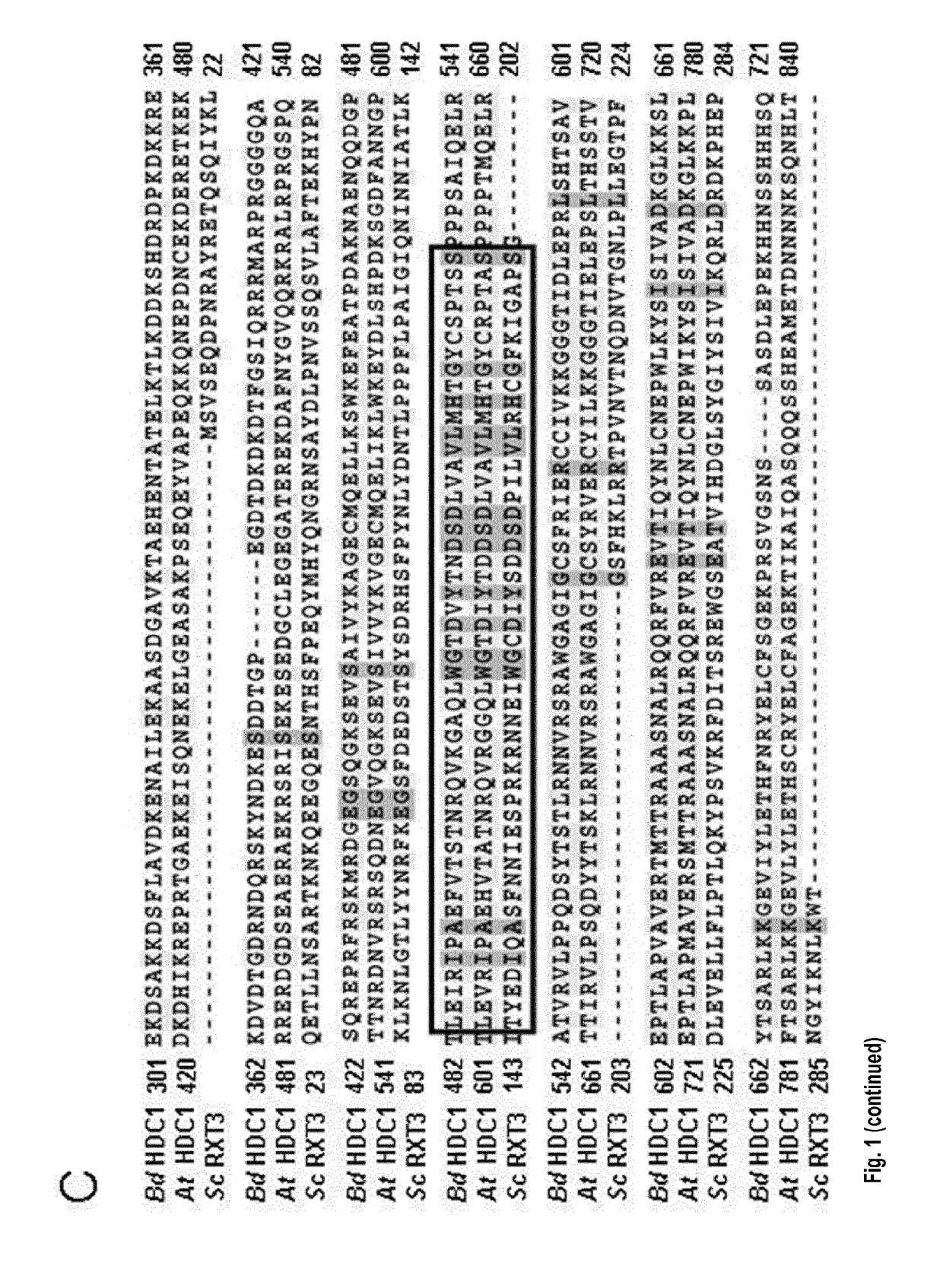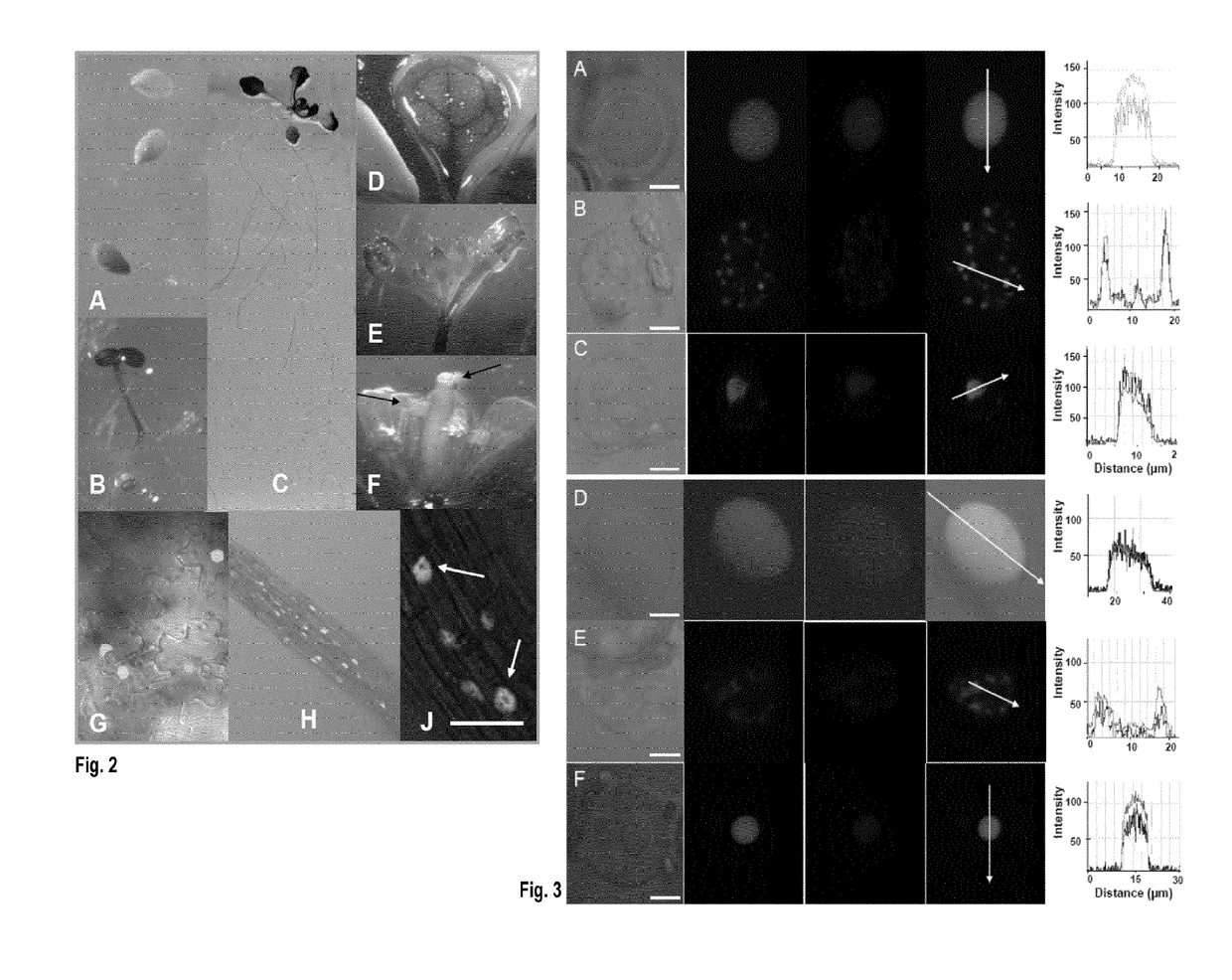Methods and means for increasing stress tolerance and biomass in plants
a stress tolerance and biomass technology, applied in the field of plant molecular biology, can solve the problems of limiting crop production, unnecessarily ‘cautious’, not all hdacs function, etc., and achieve the effect of increasing expression and/or activity
- Summary
- Abstract
- Description
- Claims
- Application Information
AI Technical Summary
Benefits of technology
Problems solved by technology
Method used
Image
Examples
example 1
tal Procedures
Plant Materials
[0229]All transgenic lines for HDC1 were generated in our laboratory in Arabidopsis thaliana Col-0 background. The stable homozygous knockout line hdc1-1 was obtained from progeny of GABI-Kat line 054G03. Stable, homozygous complementation lines were identified from the progeny of hdc1-1 plants transformed with genomic HDC1 including the native promoter (see cloning procedures). Stable, homozygous HDC1-overexpressing lines were generated from the progeny of wildtype Col-0 plants transformed with HDC1 under the control of 35-S or Ubiquitin-10 promoters (see cloning procedures). Seeds for 35S::HDA6 (Gu et al., 2011, PLoS Genet. 7) and axe1-5 (Probst et al., 2004, Plant Cell 16, 1021-1034) were kindly provided by Yuehui He and Ortrun Mittelsten Scheid.
Growth Conditions and Treatments
[0230]All experiments were carried out in controlled growth rooms at a temperature of 20-22° C. and a light intensity of 120-150 μmol PAR. Plants were grown either in long days ...
example 2
Non-Redundant, Ubiquitous, Nuclear Protein
[0242]HDC1 (At5g08450) is a single-copy gene in A. thaliana. Predicted splice variants only differ in the upstream UTR. Unique HDC1 homologues are also present in all other plant species for which genome information is currently available, including important crops such as maize and rice (FIG. 1A). The ˜900 amino-acid long sequence of the predicted plant HDC1 proteins contains a ˜300 amino-acid long sequence in the C-terminal half that is highly similar to Rxt3 proteins, which are ubiquitously present in lower eukaryotes but remain functionally uncharacterized (alignment in FIG. 1C). Particularly high sequence similarity occurs in a Pfam signature (PF08642) labeled as ‘histone de-acetylation Rxt3’ (box in FIG. 1C). The term derives from biochemical evidence that yeast Rxt3 co-elutes with the LRpd3 complex (Carrozza et al., 2005, Cell 123, 581-592.) but the region has no homology to catalytic domains of histone deacetylases. Based on sequence...
example 3
ically Interacts with HDA6 and HDA19 and Promotes Histone Deacetylation
[0245]To investigate whether HDC1 is a member of HDAC protein complexes in plants we tested co-localization and direct interaction of HDC1 with known HDACs of A. thaliana. Co-expression of full-length GFP-HDC1 with red fluorescent protein (RFP)-HDA6 or RFP-HDA19 in epidermal tobacco cells indicated tight co-localization of HDC1 with HDA6 and HDA19 in different locations within the nucleus (FIG. 3). Direct interaction was investigated by bimolecular fluorescence complementation (BiFC). To avoid misinterpretation of background fluorescence we used a new ratiometric BiFC assay (Grefen and Blatt, 2012, supra) in which N- and C-terminal halves of yellow fluorescent protein (YFP), fused to HDC1 and HDA6 / 19 respectively, and a full-length RFP, are expressed from a single vector FIG. 4A). In RFP-producing cells, a strong YFC signal was recorded for HDA6 and for HDA19, indicating successful BiFC and hence interaction of H...
PUM
| Property | Measurement | Unit |
|---|---|---|
| time | aaaaa | aaaaa |
| pH | aaaaa | aaaaa |
| temperature | aaaaa | aaaaa |
Abstract
Description
Claims
Application Information
 Login to View More
Login to View More - R&D
- Intellectual Property
- Life Sciences
- Materials
- Tech Scout
- Unparalleled Data Quality
- Higher Quality Content
- 60% Fewer Hallucinations
Browse by: Latest US Patents, China's latest patents, Technical Efficacy Thesaurus, Application Domain, Technology Topic, Popular Technical Reports.
© 2025 PatSnap. All rights reserved.Legal|Privacy policy|Modern Slavery Act Transparency Statement|Sitemap|About US| Contact US: help@patsnap.com



